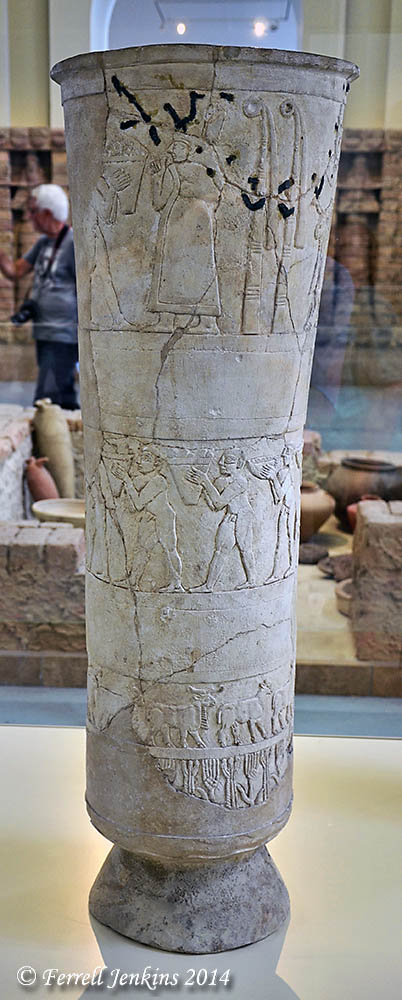The Pergamon Museum’s Ancient Near Eastern Department (Vorderasiatisches Museum) has a collection of artifacts from Uruk, now know as modern Warka in Iraq. German excavators began work at Uruk in November 1912. An English sign with the display of artifacts explains the significance of the city.
In the Old Testament, Uruk is mentioned under the name Erech, along with Babylon and other important ancient cities. But written references to Uruk extend much further into the past. The city plays a role in the Gilgamesh epic which can be traced back to the second half of the 3rd millennium BC. The legendary Sumerian king Gilgamesh whose exploits are the subject of the poem is credited with building the wall that surrounded the city. A number of objects uncovered at Uruk before 1939 came to Berlin and the museum with the division of finds following on the excavations. Together with artifacts from Babylon and Assur, they document the material legacy of ancient oriental cultures.
Uruk was the major center for the worship of the goddess Inana/Ishtar. The first photo shows a portion from the façade of the Inanna Temple built by the Kassite ruler Kara-indash at Uruk about 1413 B.C. The museum explains,
Standing male and female deities alternate in the niches. Life-giving water pours forth onto the earth from the vessels in their hands. The hump-like symbols on the projecting elements of the niched façade and on the garments of the male divinities refer to the mountainous region where the Kassites originated. An inscription on the bricks names the Kassite ruler Kara-indash as the person who commissioned the structure.

Portion of the façade of the Inanna/Ishtar Temple at Warka (Uruk/Erech). Display in the Pergamum Museum, Berlin. Photo by Ferrell Jenkins.
The next photo shows a reproduction of a limestone cult vessel from Uruk.
The Museum explains the design on the vessel.
The limestone vase from the Eanna Temple precinct at Uruk is one of the most impressive works of pictorial art produced in the Uruk Period. The arrangement of the motifs reflects the Sumerian world view, with life-giving water flowing forth in the lowest zone to sustain the plant and animal world above. The representations continue with a procession of nude men bearing votive offerings for the goddess Inanna which culminates in the upper register.
The New International Dictionary of Biblical Archaeology points out,
There are no direct references to Sumer in the Bible, although it corresponds to the “land of Shinar” mentioned eight times in the OT.
Amraphel is designated as the king of Shinar (Genesus 14:1). Notice a couple of other references.
The beginning of his [Nimrod] kingdom was Babel, Erech, Accad, and Calneh, in the land of Shinar. (Genesis 10:10 ESV)
And as people migrated from the east, they found a plain in the land of Shinar and settled there. (Genesis 11:2 ESV)
This map of southern Mesopotamia (modern Iraq) shows the location of Erech (Uruk) north of traditional Ur.
























You must be logged in to post a comment.